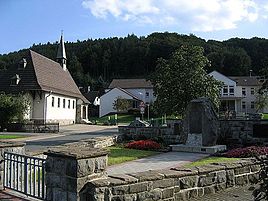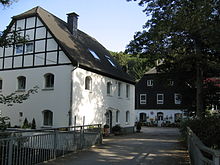Becke (Hemer)
|
Basin
City of Hemer
|
|
|---|---|
| Coordinates: 51 ° 23 ′ 57 " N , 7 ° 47 ′ 5" E | |
| Height : | 185 m above sea level NN |
| Area : | 5.53 km² |
| Incorporation : | 1st January 1975 |
| Postal code : | 58675 |
| Area code : | 02372 |
|
The former municipality of Becke within Hemers
|
|
|
Cenotaph and chapel
|
|
Becke is a district of Hemer in North Rhine-Westphalia . The city of Hemer is located in the north of the Sauerland and belongs to the Märkisches Kreis . Until the end of 1974, Becke was a parish of the Hemer Office in what was then Iserlohn district . Becke is located in the north of Hemer, on the B 7 in the direction of Menden .
The name Becke or Beck is the ancient name for Bach.
history
The origin of the peasantry and thus the Becke community has not been fully researched. The municipality of Becke was mentioned as one of the "seven farmers of the Hemer court" in 1705. Their origins - this is confirmed by the discovery of a bronze bracelet in the quarry in the Schledde - probably in a much earlier period. There was no place for Becke. The districts of Urbecke , Tannenkopf, Höcklingsen , Oese , Edelburg , Brelen and Mesterscheid formed the community, which probably got its name from the stream that flows through it. The mentioned localities, some of which are still recognizable today as settlement centers, can look back on a great age, and individual localities of the community are named earlier.
The remains of a medieval castle tower are found in the Oesetal . These remains belong to a type of castle that was widespread in Western and Central Europe from around 1000 to 1200 AD.
In 1072 the Brelen Castle was named as Bredenole . The ruin of the castle tower is likely to be one of the oldest structures in the northern part of the Märkisches Kreis.
Together with Bredenole, Hademare, today's Hemer, is mentioned among the properties that Archbishop Anno of Cologne used to furnish the Grafschaft monastery. A Höcklingsen estate was named a Limburg fief in 1377. Today's Hückingsche Hof probably consists of the remains of this estate. The noble castle, formerly Erlenburg , was first mentioned in 1400, when it changed hands by pledging. In 1486, two farms in Mesterscheid, probably belonging to brothers, are mentioned in the appraisal book of Grafschaft Mark ; both presumably free goods . The ownership of Dirick Roethoevet upp de Osse is identical to Rothhöfts Hof, whose namesake was first handed down in 1559 through a contract signature. The Kuhlmann Hof, later the Heyng restaurant and then partly long-term office and residential building for the Niemeyer company, is mentioned in 1705.
The Becke peasantry, which has become a household name since the beginning of the 18th century, got its name from the Urbecke, which was first mentioned towards the end of the 16th century.
The Becke belonged to the Hemer Mark, to the court and to the parish of Hemer since the beginning of documentary records. This neighborly bond - up to today's integration - is also quite old.
In 1932 a Catholic chapel could be established. The memorial was erected in 1933 to commemorate the 22 fallen soldiers of the First World War .
When the Sauerland / Paderborn Act came into force on January 1, 1975, the Becke municipality lost its long-term independence, but the population, whose feeling of belonging to the town of Hemer is not only based on the economic structure of the location, did not suffer serious disadvantages due to the reorganization . Commercial operations and residential developments have increased in recent years, and agriculture in the Becke district has had to give up its traditional place.
The development of the district is largely determined both in its external appearance and in the numerical strength and composition of the population by the industrial plants.
politics
coat of arms
The wavy line should represent the eyelet (Hönne) that crosses the place. The three wolf fishing rods as a symbol of the Lords of Brabeck are present in all the arms of the Hemer office. The green beech in the upper part of the coat of arms refers to the noble family Böckenförde, known as Schüngel, who used to live in the municipality .
The coat of arms was awarded on May 6, 1939 by the President of the Province of Westphalia . It went out in 1975 with the incorporation.
Economy and Infrastructure
The image and the inner structure of the peasantry changed with the arrival of industry. In the late Middle Ages, iron smelting offered a rewarding side job on the heights of the lower Oesetal. Remnants of old iron extraction, so-called racing furnaces dating from around the 14th century, can be found in abundance in the forests of the Jüberg. An iron hammer from the second half of the 17th century can be found on the grounds of the Höcklingsen estate, which the Brabecks converted into a paper mill in 1689. Via the cellulose factory, which is still known today, the company changed into the Jost company, a metal processing factory. After the Jost company ceased production, several companies found their home in the abandoned factory buildings. The Paul Keune company, which in the meantime has become a global company, also had its origins here. In order to be able to realize a sales market, these company buildings were demolished.
A brass plate hammer with a brass rolling mill was installed on the upper Oese by the Iserlohn brass union a hundred years after the hammer . The company changed hands several times, was converted into a steelworks and acquired by the Niemeyer company in 1927. This company also gave up the wire drawing shop in the Becke some time ago and stopped the production of agricultural machines. In 1815 the third larger work was created: Caspar Dietrich Piepenstock, the well-known industrial pioneer, set up a factory for thimbles and knitting needles on the lower eyelet , which employed numerous people. This plant also changed hands and finally came into the hands of Carl Vogt via CW Bals. As one of the oldest companies in Germany that manufactured ship locks and ship fittings, it had a good reputation worldwide. After the withdrawal of the brothers Winold and Theodor Vogt, the business became a branch of the Wortmann & Co. company from Iserlohn. At the turn of the century, pebbles were experimentally mined for a short time. Quarry companies with a hard limestone plant have always operated here. With the company KEUCO , Grohe etc. important companies have settled in the municipality.
A railway station had existed in the Oese since 1882 and a post office was set up in 1891. Today's primary school was built in 1913.
Individual evidence
- ^ Federal Statistical Office (ed.): Historical municipality directory for the Federal Republic of Germany. Name, border and key number changes in municipalities, counties and administrative districts from May 27, 1970 to December 31, 1982 . W. Kohlhammer, Stuttgart / Mainz 1983, ISBN 3-17-003263-1 , p. 333 .




